澳大利亚荷载规范应用
加拿大风荷载规范
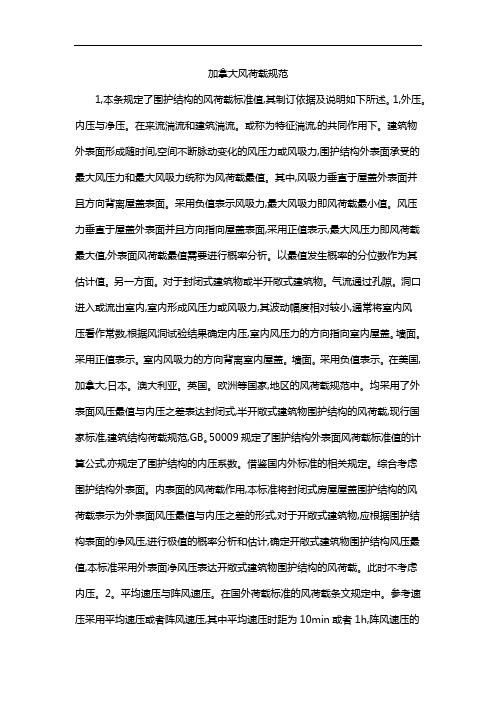
加拿大风荷载规范1,本条规定了围护结构的风荷载标准值,其制订依据及说明如下所述。
1,外压。
内压与净压。
在来流湍流和建筑湍流。
或称为特征湍流,的共同作用下。
建筑物外表面形成随时间,空间不断脉动变化的风压力或风吸力,围护结构外表面承受的最大风压力和最大风吸力统称为风荷载最值。
其中,风吸力垂直于屋盖外表面并且方向背离屋盖表面。
采用负值表示风吸力,最大风吸力即风荷载最小值。
风压力垂直于屋盖外表面并且方向指向屋盖表面,采用正值表示,最大风压力即风荷载最大值,外表面风荷载最值需要进行概率分析。
以最值发生概率的分位数作为其估计值。
另一方面。
对于封闭式建筑物或半开敞式建筑物。
气流通过孔隙。
洞口进入或流出室内,室内形成风压力或风吸力,其波动幅度相对较小,通常将室内风压看作常数,根据风洞试验结果确定内压,室内风压力的方向指向室内屋盖。
墙面。
采用正值表示。
室内风吸力的方向背离室内屋盖。
墙面。
采用负值表示。
在美国,加拿大,日本。
澳大利亚。
英国。
欧洲等国家,地区的风荷载规范中。
均采用了外表面风压最值与内压之差表达封闭式,半开敞式建筑物围护结构的风荷载,现行国家标准,建筑结构荷载规范,GB。
50009规定了围护结构外表面风荷载标准值的计算公式,亦规定了围护结构的内压系数。
借鉴国内外标准的相关规定。
综合考虑围护结构外表面。
内表面的风荷载作用,本标准将封闭式房屋屋盖围护结构的风荷载表示为外表面风压最值与内压之差的形式,对于开敞式建筑物,应根据围护结构表面的净风压,进行极值的概率分析和估计,确定开敞式建筑物围护结构风压最值,本标准采用外表面净风压表达开敞式建筑物围护结构的风荷载。
此时不考虑内压。
2。
平均速压与阵风速压。
在国外荷载标准的风荷载条文规定中。
参考速压采用平均速压或者阵风速压,其中平均速压时距为10min或者1h,阵风速压的时距为3s。
对于围护结构风荷载。
外表面风压最值表达为风压系数最值与平均速压或阵风速压之积的形式,内压表达为内压系数与平均速压或阵风速压之积的形式,加拿大。
脚手架规范

澳大利亚/新西兰标准————————————脚手架的搭设第六部分:金属管和扣件式脚手架——与AS/NZS 一致——————————————此标准是由澳大利亚标准、新西兰的BD/36标准委员会联合制定的,用于替代澳大利亚脚手架搭设的标准中关于。
预制式脚手架和管连接式脚手架,金属管和扣件式脚手架应该遵守(补充条款AS —1991)。
此标准是对在脚手架搭设的一般性设计中,对于AS/NZS 简化应用。
此版本与过去的版本主要的技术变化如下:(a) 在适用范围中说明的脚手架覆盖的高度,由45 m减至33 m。
(b) 在入口开口,平台支架和悬臂式隔挡平台(扇型)中应服从工程设计的要求已被删去。
(c) 一些多余的定义已被删掉。
(d) 修正了一些笼式脚手架的要求。
此标准作为AS/NZS 1576系列第6部分发行,当第3部分需要修正时,此部分就作为其补充。
页数第1章适用范围和概述....................................................... 错误!未定义书签。
范围 ................................................................................ 错误!未定义书签。
非适用范围..................................................................... 错误!未定义书签。
参考文件......................................................................... 错误!未定义书签。
定义 ................................................................................ 错误!未定义书签。
载荷分类......................................................................... 错误!未定义书签。
澳大利亚风荷载取值范例

Connection Details
Cladding fastened to this flange
Butt joint with four bolts
Purlin bolts
Bolts with integral washers in both the head and nut shall be used for all types of connections described in this manual as required by AS/NZS 4600, Clause 5.3.1. M12 size PB1230 lysaght standard purlin bolt (grade 4.6): M12 x 30 mm with nut. M16 size PB1645 lysaght standard purlin bolt (grade 4.6): M16 x 45 mm with nut.
6500 SC15012-2B SC15015-2B SC20015-1B SC20019-1B SC20019-2B SC25019-1B
(整理)澳大利亚路面设计规范

第一篇澳大利亚路面设计规范第一章简介1.1应用范围(1) 无结合料粒料的柔性路面;(2) 有一层或多层的半刚性材料的柔性路面;(3) 刚性路面;(4) 柔性路面加铺设计;(5) 适用于主要由荷载引起破坏的路面,由环境因素引起的路面破坏应另外考虑;(6) 路面施工水平一般的情况;(7) 未加表面层的材料不适应;(8) 不含刚性路面沥青加铺层;本规范内容包括:路基评价、路面材料评价、交通荷载分析和结构设计等。
本规范建议作为设计指南使用,而不是作为一种强制性的标准或限制。
1.2 本规范用途(1) 常规道路交通条件下的柔性路面设计,或专门荷载条件的柔性路面设计;(2) 使用者根据自己的需要按特定条件做出设计图表;(3) 柔性路面加铺设计;(4) 刚性路面设计附录A给出了本规范术语,下一章给出了路面设计系统及组成元件。
第二章路面设计系统2.1 概述路面设计目的:确定最经济的路面组成及厚度,满足预计交通荷载行驶,具有相应的服务水平。
设计者应充分了解材料、交通、当地环境及相互作用,能预测任何路面结构组合的性能,并了解所设计道路应有的服务水平。
路面设计的复杂与简单取决于模型简化程度与设计资料的充分性。
本规范包含两套设计系统(1) 新建路面设计;(2) 柔性路面加铺层设计。
但它们的基本理论与其它工程设计是相类似的。
2.2 新路面设计设计框架见图 1.2.1,可能有些因素被忽略或有些因素与其他因素合并考虑,但本图简单轻便地示出了输入变量、分析方法与决定设计方案之间的关系。
图1.2.1 设计框架图2.2.1 输入变量(1) 设计交通量轴载数、轴载分布、荷载值与轮胎压力;除考虑目前交通量外,设计期内轴载数量与组成的变化也应充分考虑。
(2) 路基与路面材料设计者应具有知识:·用来表征承载能力的强度与刚度参数;·温度、湿度、时间与破坏累积对参数的影响;·路面破坏方式与荷载(应力或应变)对路面损坏作用的量化(见表1.2.1)。
澳大利亚路面设计规范
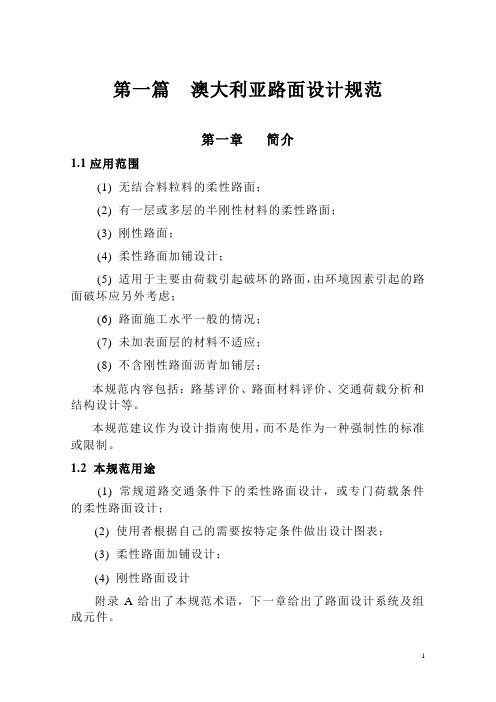
第一篇澳大利亚路面设计规范第一章简介1.1应用范围(1) 无结合料粒料的柔性路面;(2) 有一层或多层的半刚性材料的柔性路面;(3) 刚性路面;(4) 柔性路面加铺设计;(5) 适用于主要由荷载引起破坏的路面,由环境因素引起的路面破坏应另外考虑;(6) 路面施工水平一般的情况;(7) 未加表面层的材料不适应;(8) 不含刚性路面沥青加铺层;本规范内容包括:路基评价、路面材料评价、交通荷载分析和结构设计等。
本规范建议作为设计指南使用,而不是作为一种强制性的标准或限制。
1.2 本规范用途(1) 常规道路交通条件下的柔性路面设计,或专门荷载条件的柔性路面设计;(2) 使用者根据自己的需要按特定条件做出设计图表;(3) 柔性路面加铺设计;(4) 刚性路面设计附录A给出了本规范术语,下一章给出了路面设计系统及组成元件。
第二章路面设计系统2.1 概述路面设计目的:确定最经济的路面组成及厚度,满足预计交通荷载行驶,具有相应的服务水平。
设计者应充分了解材料、交通、当地环境及相互作用,能预测任何路面结构组合的性能,并了解所设计道路应有的服务水平。
路面设计的复杂与简单取决于模型简化程度与设计资料的充分性。
本规范包含两套设计系统(1) 新建路面设计;(2) 柔性路面加铺层设计。
但它们的基本理论与其它工程设计是相类似的。
2.2 新路面设计设计框架见图 1.2.1,可能有些因素被忽略或有些因素与其他因素合并考虑,但本图简单轻便地示出了输入变量、分析方法与决定设计方案之间的关系。
图1.2.1 设计框架图2.2.1 输入变量(1) 设计交通量轴载数、轴载分布、荷载值与轮胎压力;除考虑目前交通量外,设计期内轴载数量与组成的变化也应充分考虑。
(2) 路基与路面材料设计者应具有知识:·用来表征承载能力的强度与刚度参数;·温度、湿度、时间与破坏累积对参数的影响;·路面破坏方式与荷载(应力或应变)对路面损坏作用的量化(见表1.2.1)。
斐济多功能体育馆结构设计
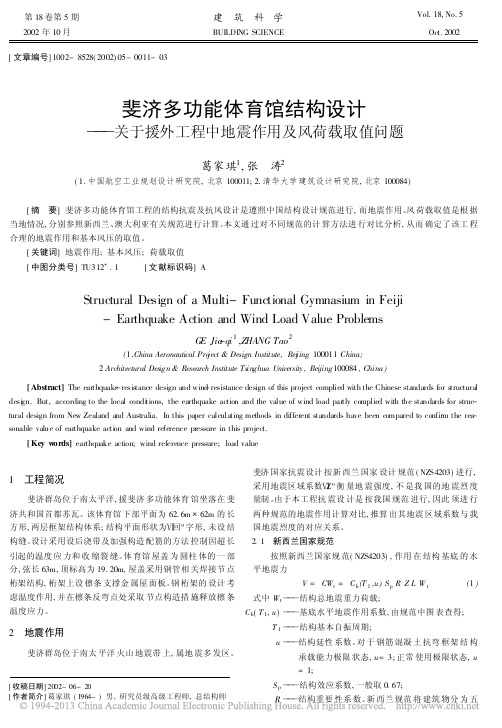
[文章编号]1002-8528(2002)05-0011-03斐济多功能体育馆结构设计)))关于援外工程中地震作用及风荷载取值问题葛家琪1,张 涛2(1.中国航空工业规划设计研究院,北京100011;2.清华大学建筑设计研究院,北京100084)[摘 要]斐济多功能体育馆工程的结构抗震及抗风设计是遵照中国结构设计规范进行,而地震作用、风荷载取值是根据当地情况,分别参照新西兰、澳大利亚有关规范进行计算。
本文通过对不同规范的计算方法进行对比分析,从而确定了该工程合理的地震作用和基本风压的取值。
[关键词]地震作用;基本风压;荷载取值[中图分类号]TU312+.1 [文献标识码]AStructural Design of a Multi-Functional Gymnasium in Feiji-Earthquake Action and Wind Load Value ProblemsG E Jia -qi 1,Z HANG Tao 2(1.China Aeronautical Pro j ect &Design Institute,Bei j ing 100011China;2.Architectural Design &Research Institute Tsin ghua University ,Beijing 100084,China)[Abstract]The earthquake -resis tance design and wind -resistance design of this project complied with the Chinese standards for s tructural desi gn.But,according to the local condi tions,the earthquake action and the value of wind load partly complied with the standards for struc -tural design from New Zealand and Australia.In this paper calculating methods in different standards have been compared to confirm the rea -sonable value of earthquake acti on and wind reference pressure in this project.[Key w ords]earthquake action;wind reference pressure;load value[收稿日期]2002-06-20[作者简介]葛家琪(1964-)男,研究员级高级工程师,总结构师1 工程简况斐济群岛位于南太平洋,援斐济多功能体育馆坐落在斐济共和国首都苏瓦。
2011-11-29译文AS NZS 1170.0 Supp 1-2002 Structural design actions - Genera
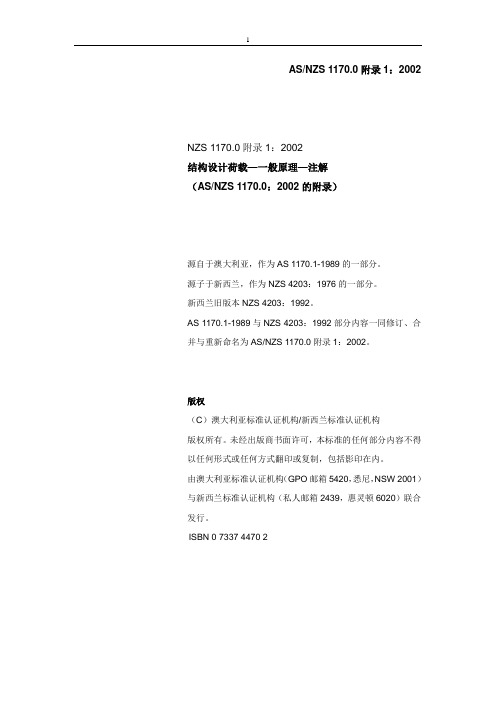
AS/NZS 1170.0附录1:2002NZS 1170.0附录1:2002结构设计荷载—一般原理—注解(AS/NZS 1170.0:2002的附录)源自于澳大利亚,作为AS 1170.1-1989的一部分。
源子于新西兰,作为NZS 4203:1976的一部分。
新西兰旧版本NZS 4203:1992。
AS 1170.1-1989与NZS 4203:1992部分内容一同修订、合并与重新命名为AS/NZS 1170.0附录1:2002。
版权(C)澳大利亚标准认证机构/新西兰标准认证机构版权所有。
未经出版商书面许可,本标准的任何部分内容不得以任何形式或任何方式翻印或复制,包括影印在内。
由澳大利亚标准认证机构(GPO邮箱5420,悉尼,NSW 2001)与新西兰标准认证机构(私人邮箱2439,惠灵顿6020)联合发行。
ISBN 0 7337 4470 2本注解由澳大利亚和新西兰联合准则委员会BD-006编制,《结构物一般设计要求与荷载》作为AS/NZS 1170.0《结构设计荷载》第0部分:一般原理的附录。
本注解内容部分取代AS 1170.1-1989《结构物最低设计荷载,第1部分:静荷载与活荷载》与NZS 4203:1992《建筑物一般结构设计与设计荷载惯例规范》(第2卷)。
本注解文件中提供了关于本标准要求的背景资料与指南。
本注解文件的条款号采用字母“C”作为前缀,使其同与之直接相关联的本标准条款号区分开来。
如果某个条款没有注解内容,则表示无需对此条款进行解释。
AS/NZS 1170系列标准将供具备一定资质的专业人员使用。
AS/NZS 1170系列标准中列出了接受无结构设计基本程序。
在特殊情况(例如,房屋结构)下提供专业解决方案的其他标准可基于这些标准中所述方法。
AS/NZS 1170系列标准中包括含有工程判断要素的条款。
这说明工程设计是一项基于科学并采用艺术与技能的创新性活动。
鸣谢澳大利亚标准认证机构对本注解文件做出重要贡献的以下成员致以感谢:G. Boughton先生P. Kleeman先生Lam Pham博士R. Potter先生第C1节范围与概述 (5)C1.1 范围 (5)C1.2 应用范围 (7)C1.3 参考文件 (7)C1.4 定义 (8)C1.5 符号 (8)第C2节结构设计程序 (9)C2.1 概述 (9)C2.2 极限状态 (10)C2.3 正常使用极限状态 (10)第C3节年超越概率(仅供在新西兰使用) (11)C3.1 概述 (11)C3.2 重要级别 (11)C3.3 设计使用寿命 (11)C3.4 年超越概率 (11)第C4节荷载组合 (12)C4.1 概述 (12)C4.2 极限状态荷载组合 (12)C4.3正常使用极限状态下的荷载组合 (15)C4.4 循环荷载 (16)第C5节分析方法 (17)C5.1 概述 (17)C5.2 结构模型 (17)第C6节结构稳定性 (19)C6.1 概述 (19)C6.2 荷载路径 (19)第C7节验证方法 (21)C7.1 概述 (21)C7.2 极限状态 (21)C7.3 正常使用极限状态 (21)附录CA 专项研究 (23)附录CB 设计试验数据的运用 (25)附录CC 使用极限指南 (27)附录CD 与AS1170.4-1993一同使用的因数 (28)附录CE 与AS1170.3-1990一同使用的因数 (29)附录CZ 附加荷载信息 (30)澳大利亚标准认证机构/新西兰标准认证机构澳大利亚/新西兰标准结构设计荷载-一般原理-注解(AS/NZS 1170.0:2002的附录)第C1节范围与概述C1.1 范围本注解文件应同AS/NZS 1170.0:2002一起阅读。
AS4100-1998澳大利亚钢结构标准资料
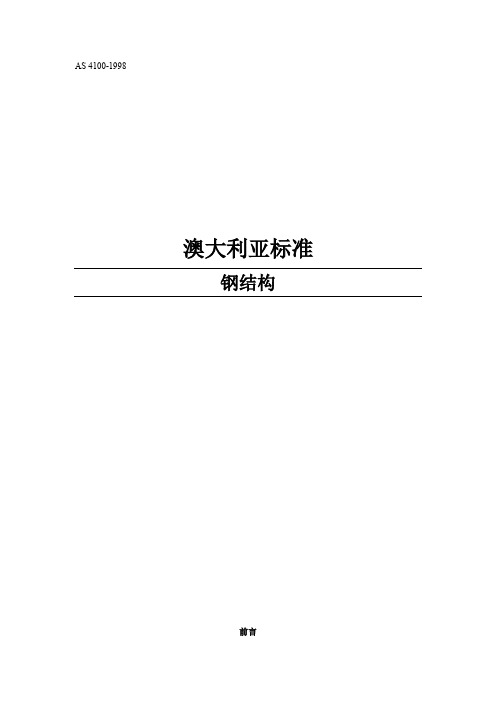
AS 4100-1998澳大利亚标准钢结构前言本标准是澳大利亚标准委员会“BD/1,钢结构”为了替代AS 4100—1990而编写的。
本标准的目标是向钢结构设计者提供有关建筑物和其他结构中的钢结构构件(用于承载目的)的规范。
本标准的这一新版本中包括:修正案1号——1992,2号——1993,3号——1995和修订版草案4号(出于公众评论目的而发行)DR 97437。
修订班草案4号并没有作为一个通用文件而单独出版发行。
修正案1号—1992包含下列主要变更:(a)钢材强度符合AS 1163和AS/NZS 1594的要求(表2.1)(b)加强腹板的抗剪弯曲载量(5.11.5.2部分)(c)承载弯曲载量(5.13.4部分)修正案2号—1993包含下列主要变更:(a)弯曲和剪力交互作用的方法(5.12.3部分)(b)中间部分横向腹板加强构件的设计最小面积(5.15.3部分)(c)构件承受组合作用的剖面载量(8.3部分)(d)对接焊缝的强度评估(9.7.2.7部分)(e)疲劳(11部分)修正案3号—1993包含下列主要变更:(a)腹板边缘的抗压承载作用(5.13部分)(b)构件承受组合作用的剖面载量(8.3部分)(c)抗压构件的平面内、外载量(8.4.2.2部分和8.4.41部分)(d)对接焊缝的强度评估(9.7.2.7部分)(e)地震(13部分)修正案4号包含下列主要变更:(a)钢材强度符合AS/NZS 3678、AS/NZS 3679.1和AS/NZS 3679.2的要求(表2.1)(b)紧固件的最小边缘距离(9.6.2部分)(c)容许使用温度,根据钢材类型和厚度(表10.4.1)(d)钢材类型和钢材等级之间的关系(表10.4.4)(e)同心支撑框架的焊接,用于处在地震设计D类和E类作用下的结构(13.3.4.2部分)本标准使用了“标准”和“提供信息用”这两个术语以对附录的适用范围几逆行能够详细说明。
“标准”附录是标准的一个主要组成部分,而“提供信息用”则仅仅是用来提供信息和指导性意见的。
- 1、下载文档前请自行甄别文档内容的完整性,平台不提供额外的编辑、内容补充、找答案等附加服务。
- 2、"仅部分预览"的文档,不可在线预览部分如存在完整性等问题,可反馈申请退款(可完整预览的文档不适用该条件!)。
- 3、如文档侵犯您的权益,请联系客服反馈,我们会尽快为您处理(人工客服工作时间:9:00-18:30)。
• Australian standards govern the design and 1. 2. 3. 4. 5. 6.
construction of most Australian structures. Several of the more important are: “Steel Structures” AS 4100-1998 4100“Concrete Structures” AS 3600-2001 3600“Residential slabs and footings-construction” footingsAS 2870 “SAA Timber Structures”, AS 1720-1997 Part 17201 Design Methods “Masonry Structures”, AS 3700 “Composite Structures”, AS 2327-1996 2327-
Loads (Actions) on Structures
• Dead load (permanent action) (AS/NZS 1170.1): the • •
weight of the structure plus the weight of permanently installed equipment,. Live load (imposed action) includes the loads for various uses and occupancies, AS 1170.1. Wind loads (actions) (AS/NZS 1170.2). For most structures, wind load can be treated as a static load. Tall, slender buildings may be designed with the aid of wind tunnel tests. Earthquake loads (actions) (AS 1170.4). Conventional earthquake (seismic) design procedures replace the dynamic earthquake loads with equivalent static loads.
The University of Sydney Department of Civil Engineering CIVL 2230 Introduction to Structural Concepts & Design
LECTURE 1 - INTRODUCTION
A structural designer must endeavour to:
1. provide a safe, reliable structure that performs
satisfactorily the function for which it was intended; 2. provide a structure that is economical to build and to maintain; 3. Provide a structure that is aesthetically pleasing. The design process for any structure contains many steps, not all of which involve the structural designer, although he/she should be involved in most of them. These steps are:
Codes, Specifications and Standards
• Building codes are written for the purpose of
protecting the public. • An Australian Standard represents the consensus of opinion of experienced engineers, architects and others. It does not cover in detail every situation which a structural designer may encounter, and the designer often must exercise judgment in interpreting and applying the requirements of a standard.
• The Building Code of Australia (BCA) is
produced and maintained by the Australian Building Codes Board (ABCB) on behalf of the Commonwealth Government and each State and Territory Government. • The BCA is a uniform set of technical provisions for the design and construction of buildings and other structures throughout Australia. It allows for variations in climate and geological or geographical conditions.
•
Methods of Analysis
• For statically determinate structures, the structures,
analysis is relatively simple, and the laws of statics can be used to determine the forces and moments on each member. • For statically indeterminate structures, the structures, procedure is more complex. Numerous analytical methods have been developed, such as slope-deflection, moment-distribution, slopemomentenergy methods, and matrix force and displacement methods.
1. a prospective owner must arrange the financing necessary to
build the structure; 2. for a building, an architect and an engineer must study the applicable building by-laws and building codes to ensure that byfire protection, health and safety requirements are met; 3. for a bridge, an engineer must ensure that navigation clearances, and highway or railway geometric requirements are met; 4. the structural designer must investigate the site to determine how site conditions will affect the structure (e.g., buried water mains on a building site); 5. the form, shape and size of the structure must be determined; 6. the probable loads (wind, earthquake, occupancy loads, snow, etc) must be estimated by the designer; 7. the most suitable structural material, or materials, must be selected, with due consideration of required performance, cost, supply, transportation to the site and construction on the site;
11.
12.
• The above twelve steps briefly summarise the
major portions of the design process for a structure. These notes will deal with several of these steps, but will cover in detail only Steps 6, 7 and 8. • The course CIVL 2230 Introduction to Structural Design will introduce Item 10. • Item 9 is covered in CIVL 3204 Structural Analysis. For simplicity, most explanations and examples will deal specifically with the design of elements of buildings.
ቤተ መጻሕፍቲ ባይዱ
8. the structural designer must compare various structural 9. 10.
